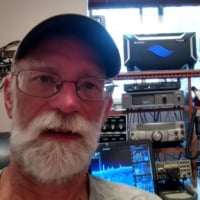Welcome to the FlexRadio Community! Please review the new Community Rules and other important new Community information on the Message Board.
Need the latest SmartSDR or 4O3A Genius Product Software?
SmartSDR v4.1.3 | SmartSDR v4.1.3 Release Notes
SmartSDR v3.10.15 | SmartSDR v3.10.15 Release Notes
The latest 4O3A Genius Product Software and Firmware
SmartSDR v4.1.3 | SmartSDR v4.1.3 Release Notes
SmartSDR v3.10.15 | SmartSDR v3.10.15 Release Notes
The latest 4O3A Genius Product Software and Firmware
If you are having a problem, please refer to the product documentation or check the Help Center for known solutions.
Need technical support from FlexRadio? It's as simple as Creating a HelpDesk ticket.
Need technical support from FlexRadio? It's as simple as Creating a HelpDesk ticket.
Questions before Purchase
John Hansen
Member
I am the owner of a FLEX 5000 (and a 1000 before that). I am considering buying a 6400 and have a few questions:
1. The 5000 was not really designed as a general coverage receiver and it's ability to receive drops off a cliff when leaving a ham band. Does the 6000 series do that as well?
2. I've gotten kind of used to the features of the KE9NS enhancement for PowerSDR, particularly the integration with DX spotters. Has anything similar been developed for the 6400?
3. The 5000 has many stages of audio adjustment in order to get the transmit audio correct. Has this been simplified on the 6400? (I'm referring to the G7CNF instructions)
4. One alternative I am considering is the IC-7610. One of the nice things about it is it gives you the choice of horizontally scrolling the panadapter as you change frequency
or holding the panadapter in one place and horizontally scrolling your receive frequency. My 5000 only allows the first option. Are both options available on the 6400?
Thanks, John W2FS
1. The 5000 was not really designed as a general coverage receiver and it's ability to receive drops off a cliff when leaving a ham band. Does the 6000 series do that as well?
2. I've gotten kind of used to the features of the KE9NS enhancement for PowerSDR, particularly the integration with DX spotters. Has anything similar been developed for the 6400?
3. The 5000 has many stages of audio adjustment in order to get the transmit audio correct. Has this been simplified on the 6400? (I'm referring to the G7CNF instructions)
4. One alternative I am considering is the IC-7610. One of the nice things about it is it gives you the choice of horizontally scrolling the panadapter as you change frequency
or holding the panadapter in one place and horizontally scrolling your receive frequency. My 5000 only allows the first option. Are both options available on the 6400?
Thanks, John W2FS
0
Answers
-
Hi John,
I have a fairly new 6400 and can use it as a general coverage receiver. It does not appear to lose sensitivity away from the ham bands.
I use the N3JFP logging software, and it feeds spots to the Flex. I can adjust where on the display they show and filter them etc. SmartSDR is really intuitive and in my opinion, very easy to use.
Not sure what audio gyrations the 5000 requires, but on the 6400, the big trick is adjusting the mic gain, then follow the NM9P videos on adjusting the TX equalizer. I did that and started getting excellent audio reports. You can set up different profiles, one for ragchew, one for DX and so forth. The set up is pretty easy and straightforward. NM9P uses a cool trick with the Full Duplex capability to make it very easy to see what you are doing with your signal.
The Flex will scroll horizontally very easily, can zoom way in or way out (7 MHz!!). The display stays put as you scroll the tuning slice back and forth. If you get near the edge of the display, the whole display scrolls horizontally. If you zoom in, it centers the display. I really like it.
I spent quite a bit of time looking at the 7610, 7300 and TS-890. Then I spent time with a friend's Flex 6400. They are all very good radios, but my preference fell solidly with the Flex.
73,
Len, KD0RC
0 -
John, you might want to download the 6400 and the Smart SDR manuals from the Flex site. Probably will answer most of your questions.
Andy... W3LI
0 -
Hi John.
#1 The 6000 radios listen to the general coverage bands well.
#2 the 6000 radios work best with 3rd party software, and they work as if they are part of SSDR software because of the easy setup of Cat and Dax. There are many programs that send spots to the panadaptor.
#3 In PSDR you have the old MIC, EQ, And LEVELER gains to set. In SSDR things are a lot more advanced. We only need to pay attention to the mic gain setting, really simple.
#4 The Flex panadaptor is about the most advanced in ham radio. very smooth. If your looking for a radio like the 7610, than you should have a look at the 6400M and 6600M radios.0 -
John - I've owned a Flex-6700 for a few years and have gotten very used to using SmartSDR (1.x, 2.x, and 3.x). Last year decided to buy a Flex-5000 mainly as a back-up, and also to see what the KE9NS software was all about.
As mentioned above, the Flex-6000 series can function as a general coverage receiver, but if you don't have a resonate antenna on those frequencies, you may find there's a loss of sensitivity, albeit still fully functional.
My hat is off to KE9NS for enhancing PowerSDR. You will find that PowerSDR (KE9NS version) has functions not found in SmartSDR (such as adjustable Diversity Receive), and visa-versa.
I ended up selling my Flex-5000 after a few months for several reasons. I found I preferred the tuning features the tuning and spectrum adjustment versatility of SmartSDR (which by the way has way more adjustment than a 7610), and also the ease of interfacing the digital modes with SmartSDR. And I also missed being able to monitor more than two bands at the same time.
You will have no problem getting your transmit EQ settings correct with SmartSDR.
0 -
Somewhat comically, a **** lesson learned for me is my awesome antenna tuner does a great job of "tuning a fork" but acts as a band pass filter if I don't switch it to bypass when I move out of band. Since antenna tuners can only be tuned using transmit within a band, do remember to switch to bypass between bands.0
Leave a Comment
Categories
- All Categories
- 377 Community Topics
- 2.1K New Ideas
- 630 The Flea Market
- 8.2K Software
- 112 SmartSDR+
- 6.4K SmartSDR for Windows
- 183 SmartSDR for Maestro and M models
- 428 SmartSDR for Mac
- 271 SmartSDR for iOS
- 258 SmartSDR CAT
- 190 DAX
- 382 SmartSDR API
- 9.3K Radios and Accessories
- 36 Aurora
- 252 FLEX-8000 Signature Series
- 7.2K FLEX-6000 Signature Series
- 944 Maestro
- 55 FlexControl
- 865 FLEX Series (Legacy) Radios
- 919 Genius Products
- 461 Power Genius XL Amplifier
- 335 Tuner Genius XL
- 123 Antenna Genius
- 296 Shack Infrastructure
- 208 Networking
- 454 Remote Operation (SmartLink)
- 144 Contesting
- 787 Peripherals & Station Integration
- 139 Amateur Radio Interests
- 1K Third-Party Software


